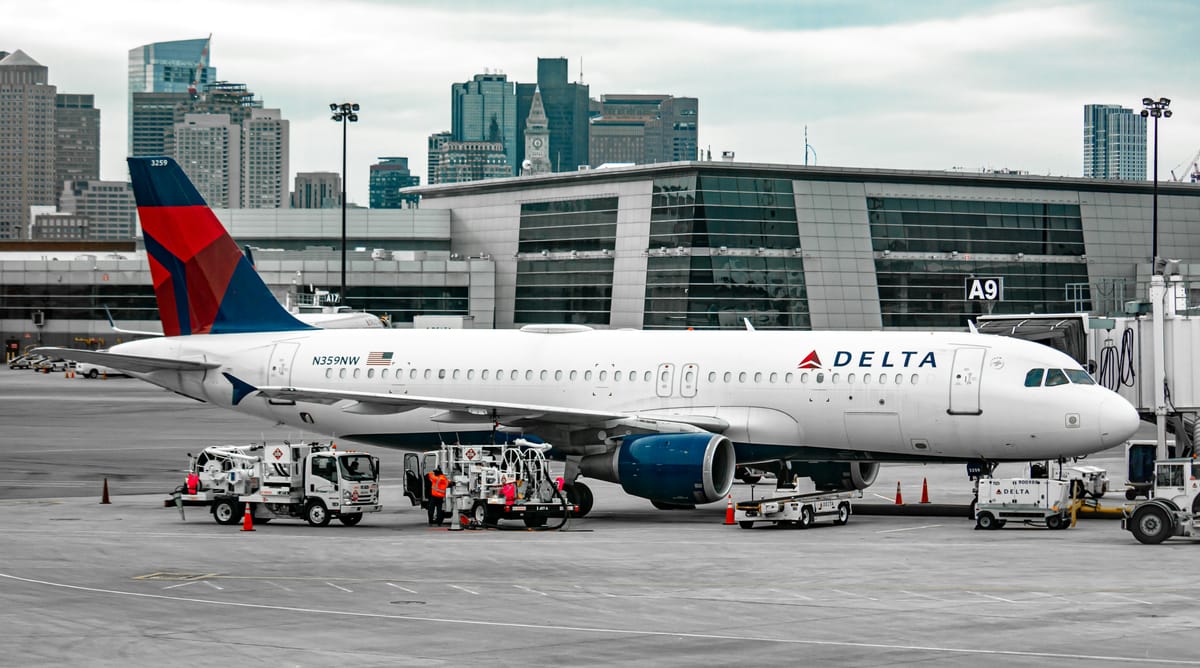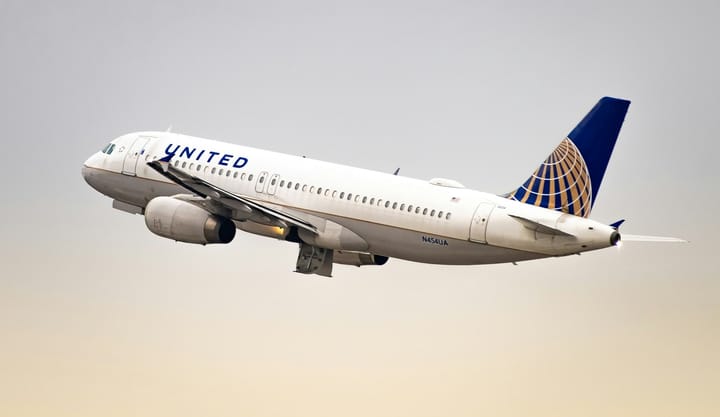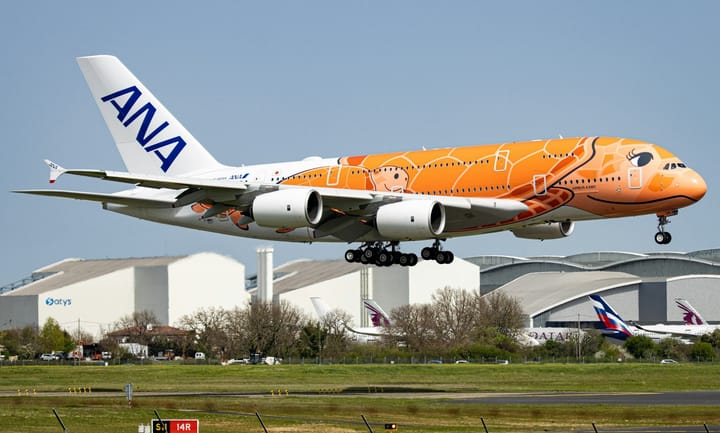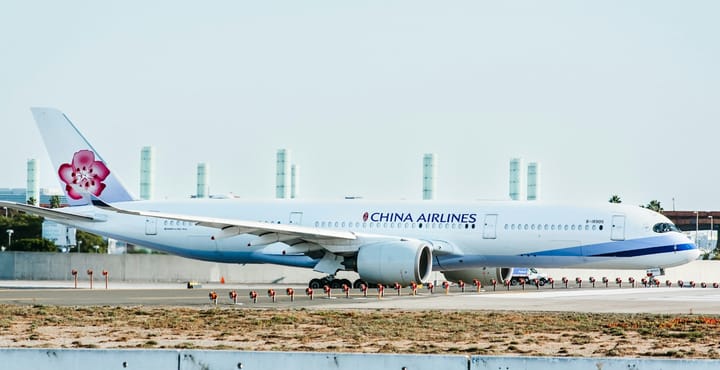A thorough evaluation of Delta Air Lines' operational & financial performance, including passenger numbers, flights, ASM, RPM, load factor, and a breakdown of revenue and net income, providing a deeper understanding of the airline’s efficiency and financial stability.
1. Total Passengers Carried
Delta Air Lines' passenger transport metrics are a direct reflection of its strategic investments in operational efficiency and customer experience. In 2024, the airline achieved an on-time arrival rate of 83.46% across 1,146,564 flights, earning Cirium's Platinum Award for Operational Excellence for the fourth consecutive year. This consistent performance underscores Delta's commitment to reliability, a critical factor in attracting and retaining passengers in both domestic and international markets.
The airline's focus on enhancing the passenger experience has also played a significant role in increasing passenger numbers. In 2023, Delta introduced fast, free Wi-Fi on most domestic mainline flights, a move that set a new industry standard and improved customer satisfaction. Additionally, the launch of Delta Sync provided personalized in-flight experiences, further differentiating Delta from its competitors and appealing to tech-savvy travelers.
Delta's strategic expansion of its global network has also contributed to its passenger growth. In 2023, the airline added 25 new international destinations, expanding its global network by 15%. This expansion not only increased passenger volumes but also enhanced Delta's competitiveness in key international markets.
The airline's commitment to sustainability has also resonated with passengers. In 2023, Delta invested $200 million in sustainable aviation fuels (SAF), demonstrating its dedication to reducing its carbon footprint. This investment aligns with the growing passenger demand for environmentally responsible travel options.
Delta's robust loyalty program, SkyMiles, has further driven passenger engagement. Enhancements to the program led to a 10% increase in enrollments in 2023, reflecting higher customer engagement and loyalty. This growth in loyalty program membership contributes to repeat business and sustained passenger numbers.
2. Total Flights Operated
Delta Air Lines' flight operations are underpinned by its strategic hub locations and global partnerships. With major hubs in Atlanta, Minneapolis-St. Paul, Detroit, and several coastal cities, Delta operates over ∼3,140 daily flights to more than 280 destinations worldwide. Its membership in the SkyTeam alliance further extends its global reach, allowing for seamless international travel and contributing to its high flight volumes.
The airline's focus on operational excellence has also played a significant role in maintaining high flight volumes. In 2024, Delta's on-time performance exceeded both North American and global industry benchmarks, with 83.46% of its flights arriving on time. This reliability is crucial in maintaining customer trust and ensuring efficient utilization of aircraft and crew resources.
Delta's investment in fleet modernization has further supported its flight operations. In 2023, the airline introduced 20 new aircraft, contributing to an 8% reduction in fuel costs and aligning with its sustainability goals. The addition of fuel-efficient aircraft enables Delta to operate more flights while managing operational costs effectively.
The airline's commitment to innovation has also enhanced its flight operations. Delta's TechOps division, the maintenance, repair, and overhaul (MRO) arm of the airline, plays a critical role in maintaining the reliability of its fleet. With over 9,600 employees and 51 maintenance stations worldwide, Delta TechOps ensures the airworthiness of Delta's fleet, supporting the airline's extensive flight operations.
Delta's strategic approach to route planning has also contributed to its high number of flights. In 2024, the airline's international capacity grew twice as quickly as its domestic capacity, reflecting its investment in expanding its global presence. This strategic growth in international routes has increased the total number of flights and enhanced Delta's competitiveness in the global aviation market.
3. Available Seat Miles (ASM)
Delta Air Lines reported 270.2 billion Available Seat Miles (ASM) in 2024, marking a 6% increase from 2023's 255.6 billion. This growth reflects Delta's strategic capacity expansion, particularly in international markets, aligning with its focus on premium services and long-haul routes. The airline's investment in fleet modernization and route optimization has enabled it to efficiently increase capacity while maintaining operational excellence.
The increase in ASM was accompanied by a stable Total Revenue per Available Seat Mile (TRASM), which remained at 21.37 cents in 2024, consistent with 2023. This stability indicates Delta's ability to manage capacity growth without diluting revenue efficiency. The airline's focus on premium cabin offerings and customer experience enhancements has contributed to sustaining high TRASM levels.
Delta's Cost per Available Seat Mile (CASM) also remained relatively stable, with a slight decrease from 19.31 cents in 2023 to 19.30 cents in 2024. This marginal improvement reflects the airline's efforts in cost management, including fuel efficiency initiatives and operational streamlining. Maintaining a stable CASM amid capacity growth is indicative of Delta's operational discipline.
The airline's fleet modernization strategy, including the introduction of 20 new aircraft in 2023, has played a significant role in enhancing ASM. These newer, more fuel-efficient aircraft have enabled Delta to increase capacity while managing operating costs effectively. The fleet renewal aligns with Delta's commitment to sustainability and operational efficiency.
Delta's ASM growth positions it as the third-largest airline in North America by capacity, following United Airlines and American Airlines. This standing reflects Delta's strategic focus on expanding its global network and offering premium services to meet evolving passenger demands. The airline's capacity growth, coupled with operational excellence, underscores its competitive positioning in the industry.
4. Revenue Passenger Miles (RPM)
In 2024, Delta Air Lines achieved 231.5 billion Revenue Passenger Miles (RPM), a 6% increase from 2023's 219 billion. This growth indicates a strong demand for Delta's services, particularly in premium cabins and international routes. The airline's focus on enhancing customer experience and expanding its global network has contributed to this uptick in revenue-generating passenger traffic.
Despite the increase in RPM, Delta's passenger mile yield experienced a slight decline, from 21.06 cents in 2023 to 20.68 cents in 2024. This 2% decrease suggests a competitive pricing environment and potential shifts in passenger preferences. However, the overall growth in RPM indicates that the airline successfully attracted more passengers, offsetting the yield decline.
Delta's load factor, a measure of capacity utilization, remained stable at 85% in 2024, consistent with the previous year. This stability reflects the airline's effective capacity management and its ability to match supply with demand. Maintaining a high load factor is crucial for maximizing revenue and operational efficiency.
The airline's focus on premium services has been a key driver of RPM growth. Investments in cabin upgrades, personalized services, and loyalty programs have enhanced the passenger experience, attracting high-yield customers. This strategic emphasis on premium offerings aligns with Delta's goal of revenue diversification and margin expansion.
Delta's RPM performance underscores its resilience and adaptability in a dynamic market environment. The airline's strategic initiatives, including fleet modernization, network expansion, and customer experience enhancements, have collectively contributed to sustained revenue passenger growth. These efforts position Delta to capitalize on future demand trends and maintain its competitive edge.
5. Passenger Load Factor (%) Analysis
In 2024, Delta Air Lines maintained a robust passenger load factor (PLF) of 85%, consistent with the previous year. This stability indicates effective capacity management and sustained demand across both domestic and international markets. The airline's strategic focus on premium services and customer experience enhancements has contributed to maintaining high load factors, reflecting efficient utilization of available seat miles (ASM).
Delta's emphasis on premium cabin offerings has played a significant role in optimizing load factors. By enhancing first-class and business-class experiences, the airline has attracted high-yield passengers, contributing to a more profitable revenue passenger mile (RPM) mix. This strategic focus has allowed Delta to maintain strong load factors while increasing revenue per available seat mile (RASM).
The airline's operational reliability, recognized by Cirium's Platinum Award for Operational Excellence for the fourth consecutive year, has also supported high load factors. Consistent on-time performance and minimal disruptions have bolstered customer trust and repeat business, ensuring steady passenger volumes and efficient capacity utilization.
6. Financial Performance Analysis
6.1. Operating Revenue ($) Performance
Delta's 2024 operating revenue of $61.8 billion represents a 6% year-over-year increase, driven by growth in passenger, cargo, and ancillary revenues. Passenger revenue accounted for $50.9 billion, up 4% from 2023, reflecting strong demand across both domestic and international markets. Cargo revenue increased by 14% to $822 million, while other revenues, including loyalty programs and ancillary services, rose by 18% to $9.9 billion. This diversified revenue growth highlights Delta's successful strategy in expanding high-margin revenue streams beyond traditional ticket sales.
The airline's focus on enhancing customer experience and expanding premium offerings has contributed to increased revenue per available seat mile (RASM). By investing in fleet modernization and digital innovations, Delta has improved operational efficiency and customer satisfaction, supporting revenue growth. Additionally, strategic partnerships and network expansions have opened new markets and revenue opportunities, further strengthening the airline's financial performance.
6.2. Net Income ($) Analysis
Delta reported a net income of $3.757 billion for 2024, a decrease from $4.609 billion in 2023. This decline is primarily attributed to increased operating expenses and non-operating losses, including a $319 million loss on investments. Despite these challenges, the airline maintained a strong operating margin and continued to generate substantial free cash flow, demonstrating resilience in a dynamic market environment.
The company's strategic focus on cost control and revenue diversification has mitigated the impact of external pressures. Investments in fuel-efficient aircraft and operational efficiency have helped manage costs, while growth in premium services and loyalty programs has supported revenue. Delta's financial discipline and adaptability position it to navigate future challenges and capitalize on growth opportunities in the evolving aviation landscape.
Delta Air Lines concluded 2024 with record financial and operational performance, achieving $61.8 billion in GAAP operating revenue and $6.0 billion in operating income, reflecting a 9.7% margin. The airline's strategic emphasis on premium services and loyalty programs contributed to 57% of total revenue, while international passenger revenue grew by 6%, led by transatlantic routes. With a return on invested capital of 12.9% and adjusted debt-to-EBITDAR ratio reduced to 2.6x, Delta demonstrated strong financial discipline. Looking ahead, the company projects earnings per share exceeding $7.35 and free cash flow over $4 billion in 2025, underscoring its robust positioning in the industry.




Comments ()